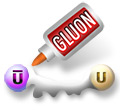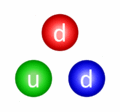Color charge of Quarks
 "Color charge" or color of quarks has nothing to do with visible colors, it is just a convenient way of referring to elements of a mathematical system that physicists have developed to explain their observations about quarks in hadrons. Quarks and gluons are said to be color-charged particles. They have three types of reaction properties known as three different types of 'color charge': green, red and blue... and being quarks they have anti-color properties for the antiquarks too!
"Color charge" or color of quarks has nothing to do with visible colors, it is just a convenient way of referring to elements of a mathematical system that physicists have developed to explain their observations about quarks in hadrons. Quarks and gluons are said to be color-charged particles. They have three types of reaction properties known as three different types of 'color charge': green, red and blue... and being quarks they have anti-color properties for the antiquarks too!
Color Neutral Particles
Particles made out of quarks, such as mesons and baryons, have no net color charge (they are color neutral).
You know that a mix of red, green, and blue light produces white light, well, in a baryon a combination of "red," "green," and "blue" color charges produce a color neutral baryon, and in an antibaryon "antired," "antigreen," and "antiblue" is also color neutral.
Mesons are color neutral because they carry combinations such as "red" and "antired."
 Exchange Particles
Exchange Particles
In the same way that electrically-charged particles interact by exchanging photons in electromagnetic interactions, color-charged particles exchange gluons in strong interactions.
Gluons carry a color and an anticolor charge, because we observe that:
 Gluon-emission and gluon-absorption always changes the color of the particle emitting or absorbing the gluon.
Gluon-emission and gluon-absorption always changes the color of the particle emitting or absorbing the gluon.
 Color is a conserved quantity
Color is a conserved quantity
The color force field
When two quarks are close to one another, they exchange gluons and create a very strong color force field that binds the quarks together. The force field gets stronger as the quarks get further apart.
Quarks constantly change their color charges as they exchange gluons with other quarks.
 |
This is an animation of the strong interaction inside a neutron. The gluons are represented as circles with the color charge in the center and the anti-color charge on the outside.
At A level this knowledge is not required but do check it out here - it is fascinating! |




 "Color charge" or color of quarks has nothing to do with visible colors, it is just a convenient way of referring to elements of a mathematical system that physicists have developed to explain their observations about quarks in hadrons. Quarks and gluons are said to be
"Color charge" or color of quarks has nothing to do with visible colors, it is just a convenient way of referring to elements of a mathematical system that physicists have developed to explain their observations about quarks in hadrons. Quarks and gluons are said to be  Exchange Particles
Exchange Particles


